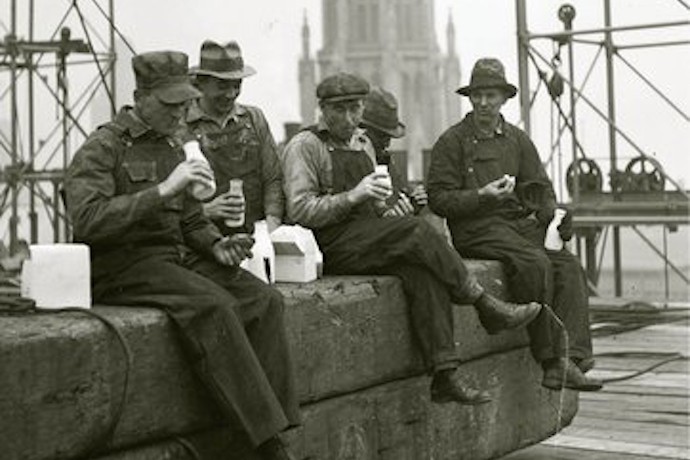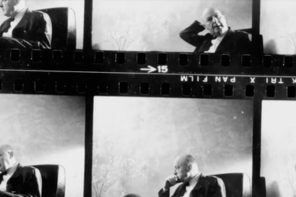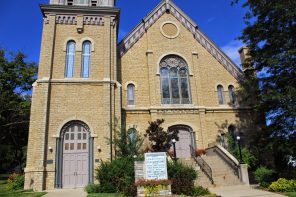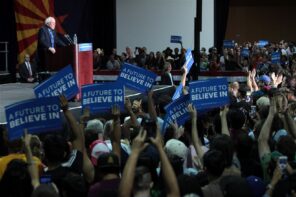Though the early 20th century Social Gospel is commonly associated with liberal clergy such as Washington Gladden and Walter Rauschenbusch, the movement has less often been attributed to organized labor. In his excellent new book, Union Made: Working People and the Rise of Social Christianity in Chicago, Valparaiso University historian Heath W. Carter credits working people with the advocacy and gradual success of the social justice faith.
When RD’s Eric C. Miller spoke with Carter about his project, he had in mind a number of parallels between the late 1800s and the early 2000s. Then as now, inequality was on the rise as the rich became richer and the poor struggled to improve their lives. Then also as now, church attendance rates began to decline as congregants grew disaffected with Church leadership. In both cases, progressive Christians have questioned the Church’s dedication to social justice over and against more political, transitory commitments.
In what follows, Carter recounts the story of working class Christianity in turn-of-the-century Chicago, with some insights for the prospect of a progressive resurgence here and now.
Your book focuses on Chicago in the late 19th and early 20th centuries, when social Christianity was championed by working people rather than established clergy. In fact, the two groups were often at odds.
That’s exactly right. While many think of the Social Gospel as a creation of the middle classes, the book argues that it was in fact working people who fueled its rise in industrializing cities such as Chicago. Throughout the Gilded Age the institutional churches were anything but bastions of progressive reform. Clergy of nearly every denomination eyed the era’s fledgling working-class movements with deep suspicion and, in many cases, outright alarm.
There were a number of reasons for this. Protestant ministers enjoyed close ties—social, political, financial, and more—to Chicago’s industrial elite, which predisposed them to be skeptical of trade unionism. In the turbulent 1870s and 1880s, as the rank and file, increasingly predominated by the foreign born, repeatedly took its protest to the streets, Protestant leaders called for violent suppression of “the mob.”
The Catholic hierarchy was less prone to such nativist excesses and yet harbored deep reservations of its own about organized labor. Even as the Vatican articulated growing support for unions in encyclicals such as Rerum Novarum, many a prelate worried that they might prove a gateway out of the Church and into the clutches of godless radicalism.
This tale of churchly opposition to the early labor movement is a relatively familiar one. What’s new in Union Made are the stories of printers, glovemakers, blacksmiths, seamstresses, and the like, who insisted that trade unionism was fully compatible with Christian faith.
More than that, these ordinary believers argued that God was on the side of the worker and that, therefore, those churches which had arrayed themselves against labor had in fact abandoned the true gospel. Intellectually, the clergy were inclined to reject such views out of hand, so workers devised another strategy to get their attention. Leveraging the working classes’ allegiance, they warned that they would have nothing to do with the churches unless the latter changed their collective tune on “the labor question.” Increasingly gripped by anxiety about a potentially catastrophic loss of influence, church leaders finally caved.
At the turn of the century—a generation after workers had first started preaching and practicing social gospels—denomination after denomination embraced the conservative brand of labor reform promoted by the American Federation of Labor. Social Christianity was union made, indeed.
The alignment of theology with class appears pretty stark. You document the growth and ornamentation of church buildings as wealthy industrialists began filling the coffers, as well as the practice of charging “pew rents,” which was new to me. Is it fair to say that these Gilded Age churches had “sold out” to the upper class?
That was certainly what many working people argued. There is no question that, as industrial warfare broke out across the late-19th-century United States, the Protestant elite sided almost exclusively with capital. Of course, even that way of putting it makes it sound like the two could be differentiated, when in many cases they could not.
In the book I discuss how Chicago’s wealthiest citizens predominated on Protestant church boards and vestries. In the early 1870s, for example, the First Congregational Church’s 14-member governing council boasted at least one prominent attorney, two influential physicians, two insurance moguls, two lumber tycoons, and two grain commissioners, one of whom was also the President of the Board of Trade.
The church paid its pastor, E. P. Goodwin, a $5,000 salary—more than ten times the earnings of the average worker—and there were other fringe benefits besides, including lucrative investment opportunities. One member at First Congregational, who was also a leading man on the Board of Trade, advised Goodwin to invest in his watch company rather than the mines. The pastor did so and received a congratulatory note in advance of a handsome dividend.
Given such material realities, working-class believers were hardly taken aback when someone like Goodwin vociferously opposed labor. During an 1885 streetcar strike, he vowed from the pulpit, “The police should clear the streets if they leave a corpse at every step.” His words earned “the silk stocking board of trade preacher” much enmity in working-class circles. One critic wrote to the Knights of Labor—borrowing a line from Sam Jones, a famed late-19th-century evangelist— “‘Hell is full of just such Christians as that.’”
Yet the “sold out” paradigm may oversimplify the dynamics at play in the sense that the alliance between the religious and economic elites was about more than money. They inhabited a shared social world within which it was difficult to imagine labor as anything other than dangerous and threatening.
And many workers agreed?
Indeed. It would be a mistake to think that all working-class people supported the trade union movement, let alone that all embraced a pro-labor vein of Christian faith. Many did not.
I delve into this theme in depth in chapter 3, which traces the religious response to the 1877 railroad riots. In Chicago, the upheaval culminated on Friday, 27 July, with police firing repeatedly into a crowd of thousands of workers at the viaduct near Halsted and 16th Streets.
That Sunday, Protestant sanctuaries across the city rang with endorsements of law enforcement’s violent suppression of “the mob.” At one Methodist church the minister declared, “One of the worst features of the riot is, it did not cost enough human lives…Something like twenty fell under that first volley; it were better if it had been 200. It would have taught those lawless beings the cost of human lives, that it cost them something to defy the law.”
While such rhetoric may seem shocking to us, it was commonplace at the time. But something in the news reports did take me aback: namely, that throughout this sermon, “the people turned to each other with looks of approval; and occasionally a movement of that sort commonly described in brackets by the intelligent reporter as ‘sensation,’ swayed them.”
Who were these people, I wondered, who reveled in such calls for violent retribution? As it turns out, many of those in the church’s pews were workers: people like James Dickson, a teamster, and Anna Quayle, a milliner. They were, on the whole, more likely than the strikers in the streets to be of English or American stock, and more likely as well to be highly-skilled artisans.
These workers had not lost faith in the industrial order and did not believe their interests would be well served by the labor movement. They cast their lot instead with their social and religious betters. There were strong incentives to do so.
As the aforementioned Rev. Goodwin once wrote, “Let any two men equally unknown make application to any firm wishing to hire, and who doubts that, other reasons being balanced, if one was certainly known to rent a pew in a church and to be regularly in it, and the other as regularly to stay away, the church goer would get the situation.” Goodwin went on, “and so it pays to go to church, pays, I mean, in actual dollars and cents.”
Those who did lose faith in the industrial order eventually also lost faith in the church—but never in Christianity. Their persistent commitments both to faith and to unions precipitated the churches’ eventual embrace of social Christianity after the turn of the century.
Yes, even as Chicago’s class-conscious workers navigated an oppositional relationship to the institutional churches, they never wavered in their conviction that God was on their side. As the turn of the century approached, this belief steeled a growing wave of working-class religious activism.
In the spring of 1894, for example, Chicago’s Trades and Labor Assembly founded a church of its own—a congregation by and for the worker. Though short-lived, the Modern Church underscored ordinary believers’ dissatisfaction with the existing religious options. As one of its leading members put it, “[the church] has strayed from the paths marked out for it by its twelve immortal walking delegates, under the supervision of the Grand Master Mechanic of the universe.”
Later that same year the Pullman Strike catalyzed a new wave of working-class religious resistance. Many Catholics stopped their subscriptions to the archdiocesan newspaper out of frustration with the editor’s refusal to side more decisively with the American Railway Union. At churches across the city’s South Side, meanwhile, Protestant churchgoers rose up against “scab ministers.”
Nowhere was the backlash more severe than at Pullman Presbyterian Church. When the minister there railed against the strike—declaring at one point, “there is a maxim that half a loaf is better than no bread, and in my judgment the employees were getting two-thirds of a loaf”—working people walked out. By the time the dust had settled the church had lost nearly twenty percent of its members. Notably, all but a handful immediately re-affiliated with other congregations, making clear that they were not abandoning the larger church but rather this particular one, which had become too closely identified with capital.
The proliferation of such incidents had clergy of every denomination on edge. Why were working people so alienated from the church? This was the subject of an 1899 article in the American Journal of Sociology. The author—a Baptist minister based out of Chicago’s South Side—interviewed workers, asking what could be done to win them back. Their words varied but their answer was resoundingly clear: “Apply the Sermon on the Mount”; “Preach Christianity instead of theology”; “Let the pastor have a personal relationship with the needs of labor. Be our champion.”
As they assimilated such data, many church leaders came to see the answer to the churches’ workingman problem and to the nation’s industrial crisis as one and the same: champion conservative labor reform.
We are now living in what some have called a “New Gilded Age,” defined by stark inequality and class resentments. In your view, what are the prospects for a new social Christianity? Can working people do it again?
Great questions. This notion of a “new Gilded Age” has caught on and not without reason, given the extent of labor’s struggles, not to mention the already historic and still growing chasm between rich and poor in the contemporary United States. But in the book I argue that the analogy only goes so far.
The late-nineteenth century witnessed roiling debates over the morality of capitalism. To be sure, some Americans in that period assumed that “the market” was a force of nature, as resistant to change as the laws of gravity. But countless others argued that the (mal)distribution of resources in their midst was immoral. Some went so far as to contend that industrial capitalism—at least as it was taking shape in cities like Chicago—was altogether incompatible with Christianity.
Working people forced these issues in the first Gilded Age and could do so again, but from what I can tell—and I should add that, as a historian, I am no expert in the business of making predictions—we’re a long way from a repeat of their late-nineteenth-century insurgency.
There are a number of historical explanations for this. Certainly the Cold War baptism of “free enterprise” as a distinctively Christian way of doing business worked to erode social Christianity’s hold at the grassroots. The surging prosperity gospel of our own times has done further damage.
All this being said, there are some favorable trends. The resources available to working people via Christianity are, if anything, more robust today than they were a century ago. The biblical case for organized labor remains intact. Meanwhile, the tradition is more clearly on their side.
In the first Gilded Age, official church statements of support for organized labor were scarce. Today, many denominations have such statements and they could be used to hold clergy and laity alike accountable in the midst of labor disputes. Given that rates of religious affiliation vastly outstrip support for unions among Americans today, there is ample room for such accountability.
One other constant bears mention here: because church life in America operates on a voluntary basis, Christian leaders are necessarily sensitive to changes in their membership rolls, which have immediate implications for their congregations’ bottom lines. This sensitivity can render religious communities susceptible to passing fads. But it can also make them more responsive to reform movements calling the churches to a more faithful witness in the world.
Working people engineered one of those in the late-nineteenth century and it is not beyond their ability to do so again.





